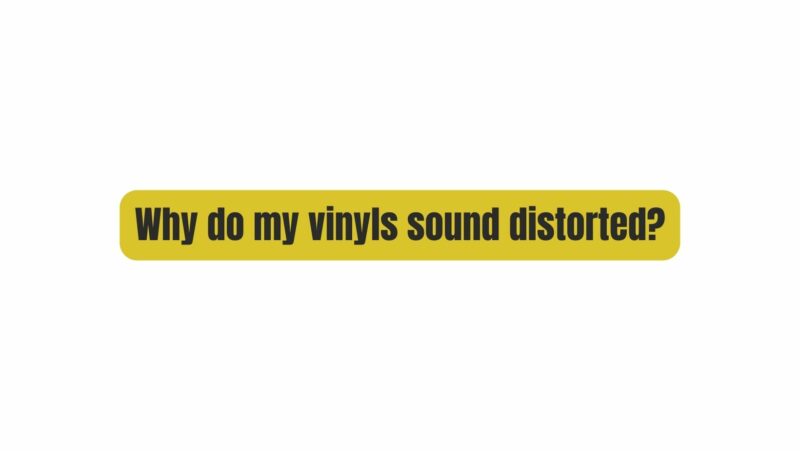The resurgence of vinyl records in recent years has brought forth a revival of analog sound, captivating audiophiles and music enthusiasts with its warm and tactile charm. However, within the vinyl experience lies a puzzling phenomenon that can bewilder collectors and aficionados alike: distortion. It’s a common query that often arises: Why do my vinyl records sound distorted? In this comprehensive article, we will embark on a journey to explore the world of distortion in vinyl records, unraveling its origins, understanding its implications on the listening experience, and providing practical insights into preserving and enhancing your vinyl enjoyment.
Section 1: Setting the Stage – The Vinyl Resurgence
1.1. The Vinyl Renaissance
Vinyl records have experienced a remarkable resurgence in recent years, appealing to those who seek an authentic and tactile connection to their music. Enthusiasts are drawn to the physicality of vinyl, the expansive album art, and the nostalgia of analog sound.
1.2. The Mystery of Distortion
Within the vinyl resurgence lies a curious phenomenon – distortion. It’s a term that sparks intrigue and sometimes frustration among vinyl enthusiasts. To fully appreciate the vinyl experience, one must unravel the enigma of distortion.
Section 2: Deciphering the Origins of Distortion in Vinyl Records
2.1. Analog Imperfections
Vinyl records are the embodiment of analog technology, where sound is captured and reproduced as continuous, physical waveforms engraved into grooves. The very nature of analog introduces certain imperfections that contribute to distortion.
2.2. Vinyl Material
The vinyl material itself can play a role in distortion. Impurities, manufacturing variations, and wear over time can all affect playback quality, leading to unwanted sonic anomalies.
2.3. Record Production
The production process, encompassing mastering and pressing, can influence distortion. Suboptimal mastering choices, such as excessive compression, may compromise the final sound quality.
Section 3: The Sonic Impact of Distortion
3.1. Texture and Character
Surprisingly, distortion is not universally perceived as a negative aspect of vinyl playback. Some vinyl enthusiasts appreciate certain types of distortion, such as harmonic distortion, for the unique sonic character and warmth it imparts to the music.
3.2. Artistic Expression
In some cases, distortion is introduced intentionally during the recording or mastering process to achieve specific artistic effects. Musicians and producers creatively use distortion to shape the sound of a recording, underscoring its role as an essential tool in the audio palette.
Section 4: Addressing the Question – Is It Normal for Vinyl Records to Sound Distorted?
4.1. Inherent to the Vinyl Medium
Distortion is, to some extent, inherent to the vinyl medium. The analog nature of vinyl introduces subtle imperfections that can manifest as distortion. Therefore, encountering some degree of distortion on vinyl records can be considered normal.
4.2. Variation in Intensity
The intensity of distortion can vary from record to record and even within different sections of the same record. Factors such as the record’s condition, pressing quality, mastering choices, and playback equipment all influence the degree of distortion.
Section 5: Strategies for Managing Distortion
5.1. Proper Record Handling and Storage
Proper handling and storage of vinyl records are fundamental for managing distortion. Avoiding physical damage, warping, and exposure to extreme temperature and humidity conditions can help preserve the quality of your collection.
5.2. High-Quality Equipment
Investing in high-quality turntables, cartridges, and styluses can help minimize distortion during playback. Proper setup and calibration of the equipment are also critical for achieving optimal sound quality.
Section 6: Embracing the Analog Imperfections
6.1. A Symbol of Authenticity
Distortion on vinyl records serves as a symbol of authenticity. It reminds us that we are engaging with a tangible, imperfect medium, where the nuances of the physical world are intricately woven into the music.
6.2. A Connection to the Past
Vinyl records offer a unique connection to the past, to the artists, engineers, and producers who crafted the music. The occasional presence of distortion is a testament to the analog heritage and the human touch that defines the medium.
Section 7: Conclusion – The Analog Journey
In conclusion, the question of why vinyl records sound distorted invites us into the heart of the analog listening experience. While distortion may be perceived as a sonic anomaly or a source of intrigue, it is an integral part of the vinyl medium’s character. It reminds us that vinyl is a tangible, tactile, and deeply human medium that captures the essence of music in a unique way.
Vinyl records offer a timeless and immersive way to connect with music, and the occasional imperfections, including distortion, are part of the medium’s enduring charm. Embrace these imperfections as part of the music, and let them transport you to a world where authenticity coexists with artistry, creating a uniquely rich and nostalgic listening experience that continues to captivate audiophiles and music enthusiasts worldwide.


